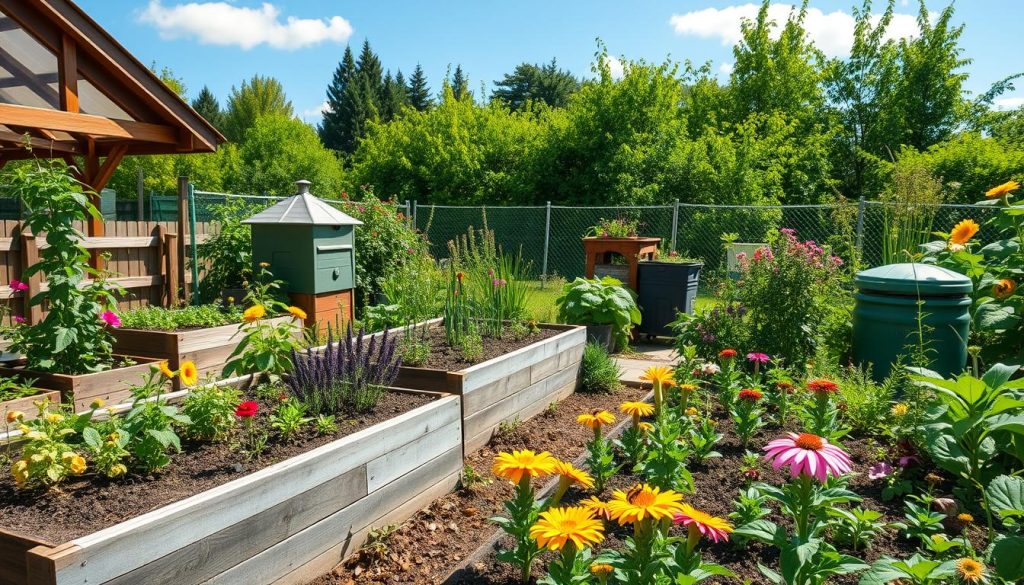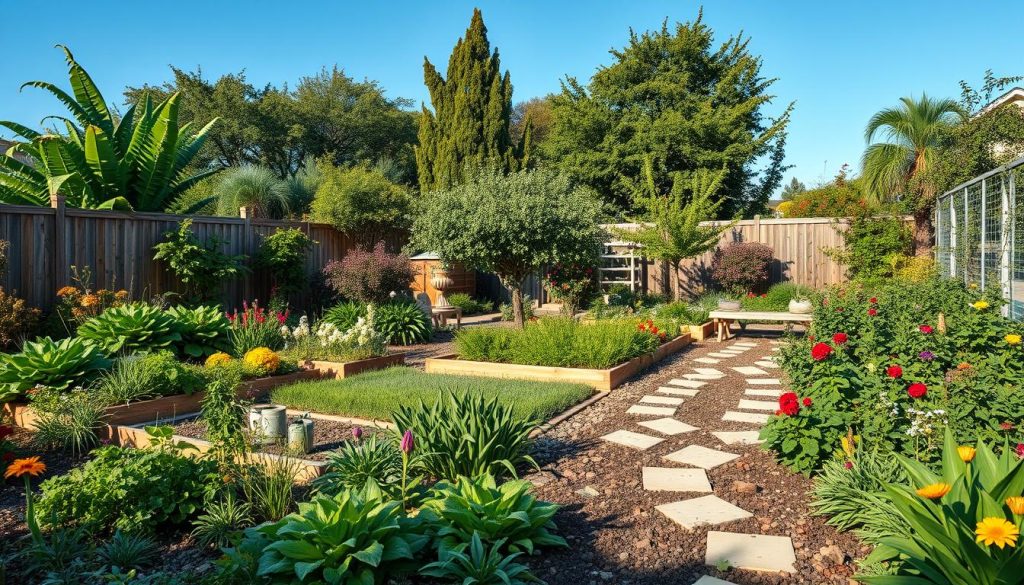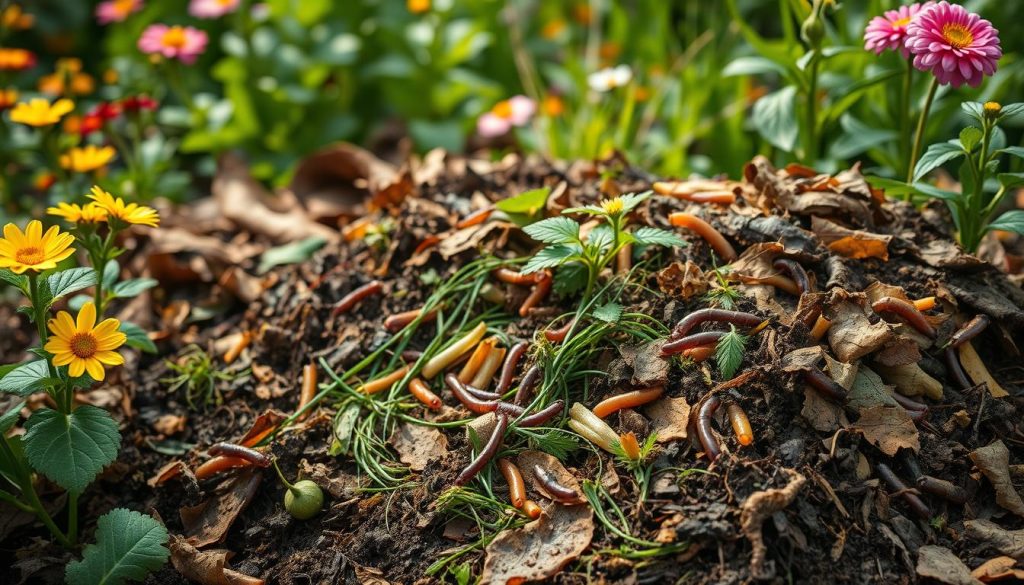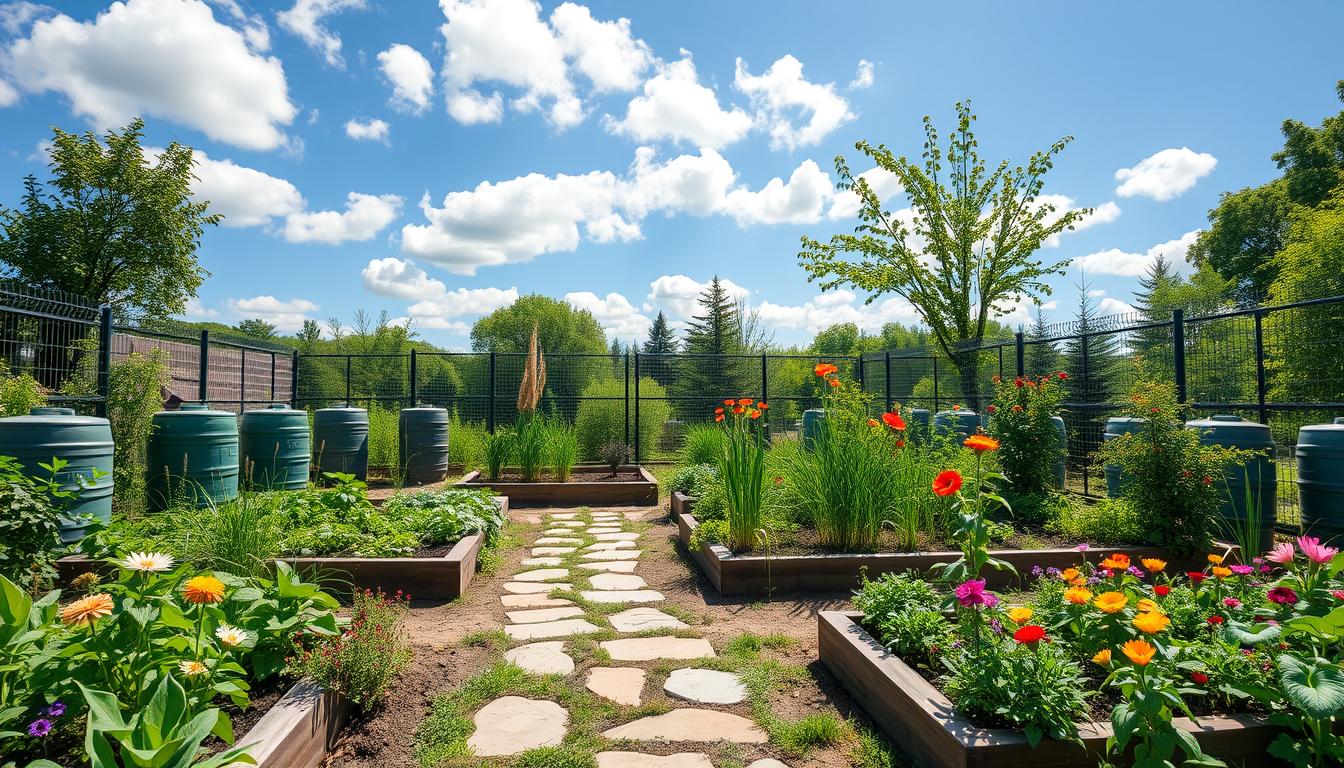I’ve always loved gardening and caring for the outdoors. It’s incredible how a simple hobby can help our planet. Eco-friendly gardening is more than just growing flowers or veggies. It’s about making outdoor spaces that are good for us and the Earth.
For me, sustainable landscaping means beautiful, green areas that work with nature. These gardens use less water, avoid harmful chemicals, and help local wildlife. They’re not only pretty; they’re also smart and efficient.
Eco-friendly gardening does more than just look good. It cleans our air, saves water, and reduces stress. It’s also a great way to meet neighbors and build a stronger community. It’s all about finding a balance between beauty and environmental benefits.
The Importance of Eco-Friendly Gardening
Eco-friendly gardening is changing how we garden. It’s good for our environment, saves money, and makes us healthier. Let’s look at why more people in the United States are choosing this green way of gardening.
Environmental Benefits of Sustainable Gardening
Using sustainable gardening helps the environment. I avoid harmful chemicals, which keeps our ecosystems healthy. My garden is a safe place for pollinators, helping plants grow well.
Economic Advantages of Green Outdoor Spaces
Eco-friendly gardening also saves money. I use less water, which lowers my bills. Growing my own food saves on grocery costs. My property value goes up because of my green garden.
Health Benefits for Gardeners and Communities
Organic farming and sustainable gardening boost my health. It keeps me active and lowers stress. Our community gardens offer fresh food and places for people to meet and learn.
Choosing eco-friendly gardening is a smart choice. It makes our gardens beautiful and useful for everyone. I highly recommend it for a healthier, greener lifestyle.
Organic Farming Techniques for Home Gardens

I’ve found that organic farming can make any home garden thrive. It’s not just about growing plants; it’s about creating a sustainable space. This approach has made my garden healthier and helped the environment.
One important part of organic farming is controlling pests naturally. Companion planting is a great way to do this. For instance, marigolds near tomatoes keep away bad bugs. I also use neem oil and diatomaceous earth to keep my garden safe from pests without chemicals.
Improving the soil is key to organic gardening. I make compost from kitchen scraps and yard waste. This compost feeds my plants and makes the soil better. I also plant cover crops like clover to help the soil during the off-season.
Crop rotation is another important part of my gardening. It keeps the soil healthy and reduces pests. This has really helped my garden grow more.
- Use companion planting for natural pest control
- Enrich soil with homemade compost
- Implement crop rotation to maintain soil health
By using these organic farming methods, I’ve made a garden that’s good for the planet. It’s a joy to grow my own food without harming the environment. It connects me to nature and makes my backyard a greener place.
Principles of Permaculture in Backyard Design

I’ve found that permaculture can turn any backyard into a green haven. By using these principles, I’ve made a space that works with nature. It’s a place where everything fits together well.
Zones and Sectors in Permaculture Planning
I’ve split my garden into zones based on how often I visit. Zone 1 is right by my door, filled with herbs and veggies I use every day. The farther out, the less often I need to tend to them. This way, I save time and energy.
Integrating Edible Landscapes
I’ve swapped out regular plants for ones I can eat. My front yard now has fruit trees and berry bushes. They look great and give me fresh food right at home. It’s a mix of beauty and usefulness in my garden.
Creating Closed-Loop Systems
My backyard is like a mini-ecosystem now. Kitchen scraps go into compost, which feeds my plants. Rainwater harvesting gives my garden most of its water. This way, I’ve cut down on waste and made a garden that takes care of itself.
Permaculture has changed how I garden. It’s not just about growing plants. It’s about making a space that’s good for me and the planet.
Mastering the Art of Composting

Composting is a big deal for gardening and outdoor sustainability. It’s like making black gold for your plants! Let’s explore how to turn waste into something amazing.
First, let’s look at compost systems. I’ve tried a few, and these three are my favorites:
- Bin composting: Ideal for small spaces
- Pile composting: Best for bigger gardens
- Tumbler composting: Simple to use and maintain
So, what can you put in your compost? I mix “greens” (nitrogen-rich stuff) and “browns” (carbon-rich stuff) in a 1:3 ratio. Here’s a quick guide:
| Greens (Nitrogen) | Browns (Carbon) |
|---|---|
| Fruit and vegetable scraps | Dry leaves |
| Coffee grounds | Shredded paper |
| Grass clippings | Sawdust |
Keeping the compost moist is key. It should feel like a wrung-out sponge. If it’s too dry, add water. If it’s too wet, add more browns.
Don’t forget to turn your compost often. This helps it breathe and decompose faster. In 2-3 months, you’ll have rich compost to feed your garden!
Composting is not just for gardening; it’s a big part of outdoor sustainability. It cuts down on landfill waste and gives you a valuable resource at home. Try it out – your plants will love you for it!
Water Conservation Strategies for Sustainable Gardens
Water conservation is crucial for sustainable gardens. Smart strategies help us keep our gardens beautiful while using less water. Let’s look at some effective ways to make our gardens thrive without wasting water.
Rainwater Harvesting Methods
Collecting rainwater is a simple yet powerful way to save water. I use rain barrels to catch roof runoff, giving my plants free water. This saves money and cuts down on the demand for municipal water.
Efficient Irrigation Systems
Drip irrigation has changed how I water my garden. It delivers water right to the roots, cutting down on evaporation and runoff. Switching from sprinklers to drip irrigation has saved me a lot of water.
Drought-Resistant Planting Techniques
Xeriscaping is my favorite way to create a low-maintenance, water-saving garden. I choose native and drought-tolerant plants, which need less water. Grouping plants with similar water needs makes irrigation easier.
| Water Conservation Technique | Estimated Water Savings |
|---|---|
| Rainwater Harvesting | Up to 1,300 gallons per year |
| Drip Irrigation | 30-50% compared to sprinklers |
| Xeriscaping | 50-75% reduction in water use |
Using these water-saving strategies, I’ve made a sustainable garden that needs very little water. It’s fulfilling to see my garden flourish while helping to protect our water resources.
Embracing Native Plants in Your Landscape
I’m thrilled to share my passion for native plants in gardening and outdoor sustainability. These local wonders bring many benefits to your garden. They thrive in our climate, making them ideal for eco-friendly gardens.
One great thing about native plants is how little care they need. They’re made for our local weather, so they use less water and need fewer pesticides. This means you’ll do less work and your garden will be healthier.
Native plants are also key for local wildlife. They offer food and shelter for birds, butterflies, and insects. By planting natives, you’re creating a mini-ecosystem in your backyard!
Here’s a quick guide to some popular native plants and their benefits:
| Native Plant | Benefits | Best Growing Conditions |
|---|---|---|
| Purple Coneflower | Attracts butterflies, drought-resistant | Full sun, well-drained soil |
| Black-Eyed Susan | Long blooming period, deer-resistant | Full sun to partial shade, average soil |
| Switchgrass | Erosion control, winter interest | Full sun, adaptable to various soils |
| Buttonbush | Supports pollinators, tolerates wet soil | Full sun to partial shade, moist to wet soil |
Adding native plants to your garden is a simple yet powerful step towards sustainable living. Start by adding a few native species to your garden. You’ll soon see how it improves your garden’s health and biodiversity.
Urban Gardening: Making the Most of Limited Space
Living in the city doesn’t mean you have to give up on gardening. Urban gardening is a trend that brings nature to the city. I’ve found creative ways to use small spaces for gardening, promoting sustainability outdoors.
Vertical Gardening Solutions
When there’s no room on the ground, I look up! Vertical gardening turns walls and fences into green spaces. I use hanging planters and trellises for herbs, flowers, and veggies. It saves space and makes homes look beautiful.
Container Gardening for Small Spaces
For small patios and balconies, I choose container gardening. I pick pots of different sizes for tomatoes and citrus trees. The right pot size and drainage are key. This lets me change my garden layout and move plants inside when it’s cold.
Community Garden Initiatives
When I don’t have enough space, I join community gardens. These shared spaces unite neighbors and promote green living. We grow food, share tips, and work on making cities greener. It’s a great way to grow my garden beyond my home.
Urban gardening shows that anyone can have a garden, no matter the size. It’s more than growing plants; it’s living sustainably in the city.
Sustainable Landscaping: Beyond Plants
I’ve learned that sustainable landscaping is more than just picking plants. It’s about making your whole outdoor space friendly to the earth. When planning my yard, I choose eco-friendly materials for paths and walls.
This helps reduce waste and save resources. Lighting is also key in sustainable landscaping. I use energy-saving LED bulbs for my outdoor lights.
They look great and use much less power than old bulbs. I’ve also set up timers for the lights. This saves even more energy and protects wildlife from too much light at night.
I also love making my yard a home for local wildlife. I’ve added bird baths, butterfly gardens, and small ponds. These features bring life to my space and support the local ecosystem.
It’s amazing to see how these small changes can make a big difference. By combining these ideas with biodynamic agriculture practices, I’ve made my outdoor space beautiful and earth-friendly. It’s a rewarding way to enjoy nature while helping the environment.
